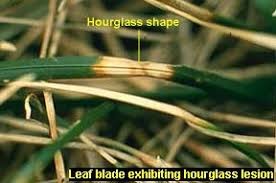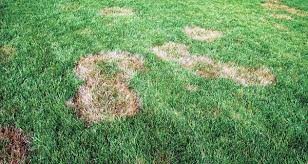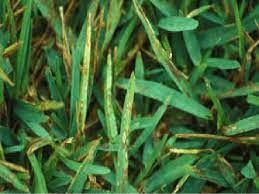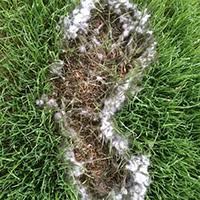We all strive to have a healthy green lawn throughout the summer. However, as the weather warms and the humidity increases the environment becomes favorable for turfgrass disease. These diseases can cause discoloration and even plant death. Learn how to identify summer lawn disease symptoms early and prevent significant damage to your lawn. Let’s take a look at 4 of the most common summer lawn diseases.
1. Dollar Spot

Is one of the most common summer lawn diseases. It gets its name by creating bleached spots in the grass about the size of silver dollars. When the spots are numerous they often overlap creating large brown areas. Many times they are confused with drought stress. The leaves of an infected plant will have straw-colored bands across the leaf blades with reddish-brown borders. Warm days, cool nights and humid conditions favor disease activity. Grasses with low fertility are most susceptible. Though Dollar spot rarely kills turf heavy infestations will thin the lawn.
2. Brown Patch

Brown patch will generally create circular patches ranging from several inches to several feet in diameter. The leaves of infected plants will be tan in color with dark brown borders. It is one of the few diseases that can impact tall fescue. It is favored by warm humid conditions especially when nighttime temperatures exceed 70 degrees. Succulent heavy fertilized lawns are often the most susceptible. Though mostly superficial this summer lawn disease can progress to the crown of the plant causing dieback.
3. Gray leaf spot

Grey leaf spot is another lawn disease that appears in the summer and has become more common in our area. The infected leaf has small tan to gray spots with dark borders. The spots often appear the length of the entire leaf blade. Severely infected plants will turn brown and die often leaving a burned appearance similar to drought stress. Temperatures between 80-90 degrees with high humidity can cause rapid development. Younger grass plants are the most susceptible.
4. Pythium Blight
Is the most dangerous summer lawn disease. They first appear as dark-colored circles or irregular spots. As the disease progresses the spots will merge causing large darkened dead areas. They often have a slimy or greasy feel. In poorly drained areas the disease is most severe. It often follows the movement of water. Hot, humid, rainy weather favors this disease. Temperatures of 85 to 95 degrees with high humidity is especially conducive to this disease. Under optimum conditions, a stand of turf can be wiped out overnight.
It is important to take a closer look at brown areas on your lawn. Though you may think it is from drought or heat stress it can just as easily be a disease. Fortunately, early detection can help prevent plant death and costly seeding. Properly timed fungicides can also help prevent the spread of diseases. By taking a closer look you can retain a green healthy lawn throughout the summer.


